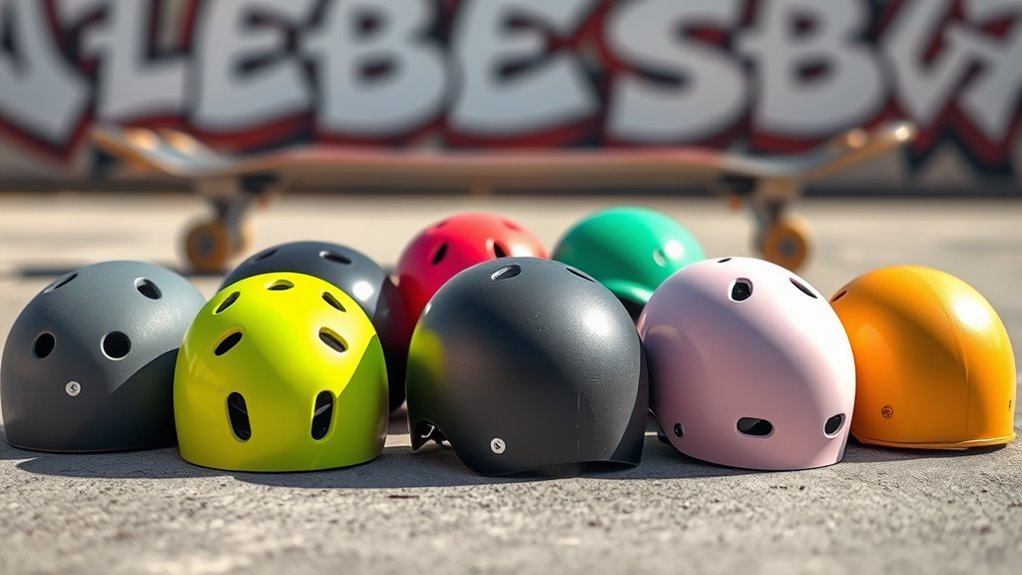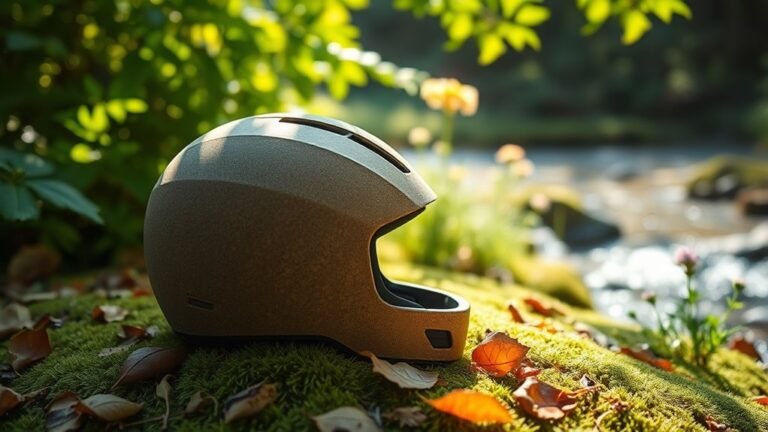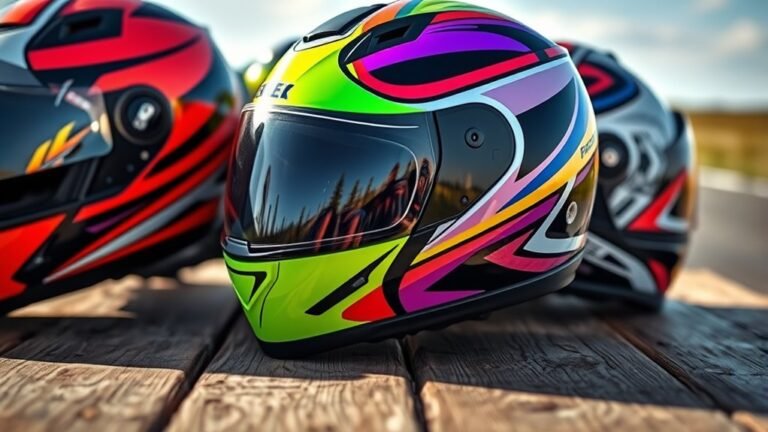Choosing the Best Skateboarding Helmet for Beginners
Choosing the best skateboarding helmet as a beginner is essential for your safety and comfort. Look for full face or skate style helmets that meet safety standards like CPSC and ASTM. Confirm a snug fit by measuring your head and adjusting straps accordingly. Materials like polycarbonate and EPS foam enhance impact protection. Consider ventilation for longer, enjoyable rides. Finally, explore various styles that reflect your personality. There are significant details ahead that can further guide your selection.
Understanding the Importance of Helmet Safety
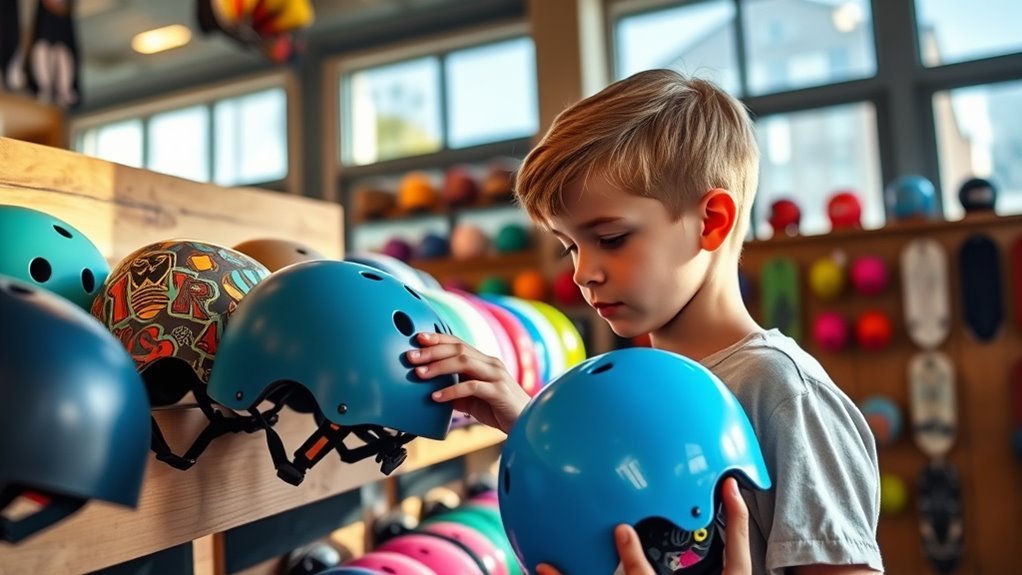
While you might think that a skateboard helmet is just another piece of gear, its importance can’t be overstated. Many people harbor misconceptions about helmets, believing they’re uncomfortable or unnecessary. However, injury statistics reveal that wearing a helmet considerably reduces the risk of traumatic brain injuries during skateboarding accidents. In fact, the CDC reports that helmets can decrease the likelihood of severe head injuries by up to 85%. By embracing helmet safety, you’re not only protecting yourself but also setting an example for others in the skateboarding community. Remember, freedom comes with responsibility; prioritizing your safety allows you to skate with confidence and enjoy the ride. So, don’t let misconceptions deter you from making a smart choice.
Types of Skateboarding Helmets
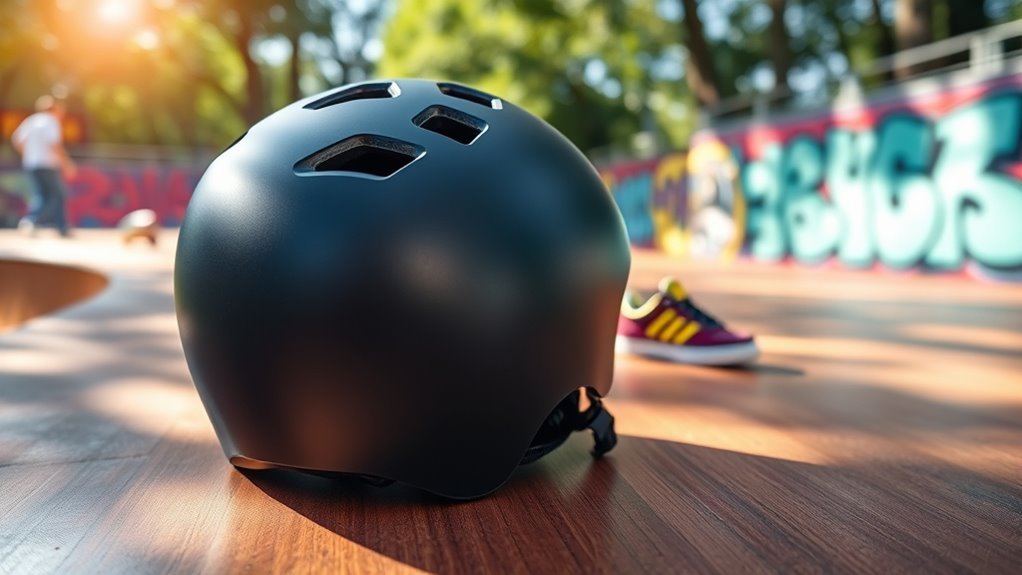
When you’re selecting a skateboard helmet, it’s essential to understand the different types available, as each serves unique purposes and offers varying levels of protection. Full face helmets provide maximum coverage, protecting not just your head but also your face, making them ideal for aggressive riding or downhill skating. They’re perfect if you want to push your limits while keeping safety a priority. On the other hand, skate style helmets are more minimalist, offering a classic look with ample protection for casual skating. They’re lightweight and breathable, giving you freedom of movement. Ultimately, your choice depends on your skating style and comfort level, so weigh the pros and cons to find what suits you best.
Key Features to Look for in a Helmet
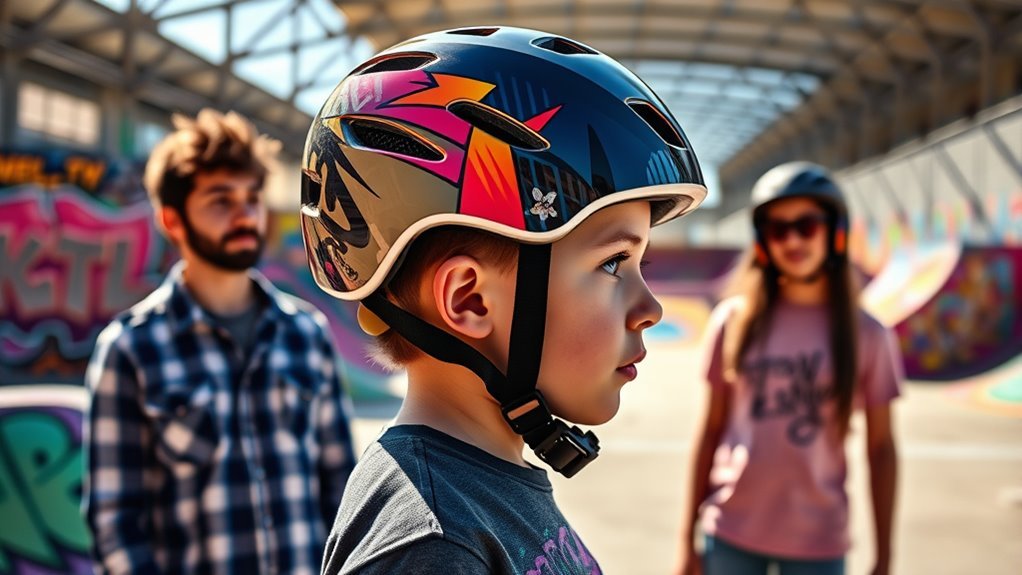
When choosing a skateboard helmet, it’s crucial to focus on key features that guarantee your safety and comfort. Look for compliance with safety standards, as this indicates the helmet’s ability to protect you during falls. Additionally, a comfortable fit with proper padding and effective ventilation can greatly enhance your riding experience.
Safety Standards Compliance
Choosing a skateboard helmet that complies with safety standards is vital for protecting your head during rides. Look for helmets that carry reputable safety certifications like CPSC, ASTM, or EN 1078, as these indicate the helmet has undergone rigorous helmet testing. These certifications guarantee that the helmet meets specific impact resistance and durability criteria, essential for skateboarders who want to enjoy their freedom without compromising safety. Additionally, check for compliance with multi-impact testing standards, which can provide added protection during falls. Ultimately, investing in a helmet that meets these safety standards not only gives you peace of mind but also enhances your overall skateboarding experience, allowing you to push your limits with confidence.
Comfortable Fit and Padding
A comfortable fit is essential for any skateboard helmet, as it directly impacts both safety and performance. When choosing a helmet, pay close attention to the padding materials—high-quality foam can considerably enhance comfort while absorbing impact. Look for helmets that feature removable and washable padding, so you can maintain hygiene without sacrificing comfort. Adjustable straps are another critical component; they allow you to customize the fit for your unique head shape. A well-fitted helmet should sit snugly without being overly tight, ensuring it stays in place during your rides. Remember, a helmet that feels good encourages you to wear it every time you skate, promoting both your safety and your freedom to express yourself on the board.
Ventilation and Breathability
Ventilation plays an essential role in the overall performance of a skateboard helmet, directly affecting your comfort during long sessions. When you’re cruising around, you need effective airflow efficiency and heat management to keep your cool. Here are four key features to look for:
- Air Vents: Adequate openings allow hot air to escape and fresh air to circulate.
- Moisture-Wicking Liner: This keeps sweat at bay, enhancing comfort during intense rides.
- Adjustable Ventilation: Some helmets let you customize airflow based on conditions.
- Lightweight Materials: A lighter helmet encourages longer wear without fatigue.
Choosing a helmet with these features guarantees you can ride freely without overheating, making your skateboarding experience even more enjoyable.
Proper Fit and Sizing Guidelines
When it comes to selecting a skateboarding helmet, guaranteeing a proper fit is essential for your safety and comfort. Start by taking proper measurements of your head circumference, typically just above your ears and across your forehead. Use a flexible measuring tape for accuracy. Once you have your size, check the manufacturer’s sizing chart for guidance. Many helmets come with adjustable straps, allowing you to customize the fit for maximum security. The helmet should sit snugly without pinching or causing discomfort. Confirm that it doesn’t move when you shake your head. A well-fitted helmet not only enhances your riding experience but also provides the protection you need as you embrace the freedom of skateboarding.
Material and Construction Quality
When choosing a skateboarding helmet, the material and construction quality are essential for your safety. Different shell materials, like ABS and polycarbonate, offer varying levels of durability, while the liner’s impact protection can greatly affect how well the helmet absorbs shocks. Understanding these factors helps guarantee you select a helmet that meets your needs.
Shell Material Types
Selecting the right shell material for your skateboarding helmet is essential for ensuring safety and comfort. Different materials offer unique benefits, so you’ll want to choose wisely. Here are some key options:
- Polycarbonate: Lightweight yet tough, it’s known for its polycarbonate advantages, like impact resistance and affordability.
- Fiberglass: Renowned for its durability, fiberglass provides excellent strength and can withstand multiple impacts, making it a favorite among seasoned skaters.
- ABS Plastic: This budget-friendly option is durable but heavier than polycarbonate.
- Carbon Fiber: Lightweight and incredibly strong, it offers superior protection but often comes at a higher price point.
Liner Impact Protection
While the shell material plays a significant role in helmet safety, the liner’s impact protection is equally essential. You’ll want to focus on the quality of the liner, as it directly influences how well your helmet absorbs impacts. Look for helmets that undergo rigorous liner durability testing to guarantee they can withstand the wear and tear of your adventures. High-quality liners often incorporate advanced impact absorption techniques, such as expanded polystyrene (EPS) foam, which helps dissipate energy during a fall. This not only enhances your safety but also gives you the freedom to skate with confidence. Remember, a helmet’s effectiveness hinges on both its shell and liner, so choose wisely for your skating journey.
Ventilation for Comfort During Rides
How can proper ventilation enhance your comfort during skateboarding sessions? A well-ventilated helmet features airflow channels that promote effective heat management, keeping your head cool as you ride. When you’re comfortable, you can focus on your moves rather than distractions caused by overheating.
Consider these factors when selecting a helmet:
- Airflow Design: Look for helmets with strategically placed vents to maximize airflow.
- Material Breathability: Choose helmets made of breathable materials to reduce sweat buildup.
- Weight: A lighter helmet can enhance comfort, giving you more freedom to ride.
- Fit and Adjustability: Guarantee a snug fit that allows for ventilation without compromising safety.
With the right ventilation, you can enjoy longer, more exhilarating rides without discomfort.
Style and Design Options
When it comes to skateboarding helmets, style and design options play an essential role in both personal expression and functionality. You want a helmet that not only protects but also complements your unique vibe. Design trends have shifted towards sleek, minimalistic looks, but there’s still room for bold graphics and patterns. Explore various color options that resonate with your personality—vibrant hues, matte finishes, or classic neutrals can all make a statement. Consider how the design impacts visibility; brighter colors can enhance safety while still looking stylish. Ultimately, the right helmet should reflect who you are on the board while ensuring you feel confident and free during every ride. Choose wisely, and wear your style with pride.
Certifications and Safety Standards
Choosing a skateboard helmet isn’t just about style; safety is paramount. You need to guarantee your helmet meets safety ratings established by certification agencies. These certifications confirm that your helmet can withstand impacts and protect your head.
Consider these vital aspects when selecting your helmet:
- CPSC Certification: Guarantees compliance with safety standards in the U.S.
- ASTM Certification: Validates performance for skateboarding and other extreme sports.
- EN 1078 Certification: European standard for bicycle and skateboard helmets.
- Snell Certification: A mark of advanced safety performance.
Maintenance and Care for Your Helmet
While you may be focused on the thrill of skateboarding, proper maintenance and care for your helmet are vital to guarantee it remains effective in protecting your head. Regular helmet cleaning is important; wipe down the exterior with a damp cloth and mild soap. Avoid harsh chemicals that could damage the material.
For storage tips, keep your helmet in a cool, dry place away from direct sunlight to prevent warping.
Here’s a quick reference table for maintenance:
| Task | Frequency |
|---|---|
| Clean exterior | After each use |
| Check straps | Before each ride |
| Inspect padding | Monthly |
| Store properly | After each session |
Following these tips guarantees your helmet stays in top condition, allowing you to skate freely and safely.
Frequently Asked Questions
How Often Should I Replace My Skateboard Helmet?
You should replace your skateboard helmet every 3-5 years, like renewing your favorite pair of sneakers. Over time, helmets can degrade, losing their effectiveness in protecting you. Keep an eye on the helmet’s condition and any safety standards; if you notice cracks or wear, it’s time for a new one. Stay proactive about your safety, because a reliable helmet is essential for enjoying your freedom on the board without the worry of injury.
Can I Wear a Bike Helmet for Skateboarding?
Yes, you can wear a bike helmet for skateboarding, but it might not be ideal. Bike helmets typically meet different safety standards than skateboarding helmets, which are designed for more impact protection from falls. While both helmet types offer some safety, skateboarding helmets are often better suited for the specific risks of skating. If you’re serious about skating, investing in a proper skateboard helmet is a wise choice for maximum protection and freedom.
Are All Helmets Compatible With Skateboarding Accessories?
Not all helmets are compatible with skateboarding accessories. When you’re zooming down the street, you want a helmet that meets safety standards specifically designed for skateboarding. Look for features like a snug fit, reinforced outer shell, and adequate ventilation. Some bike helmets may not provide the same protection or accessory compatibility, so it’s vital to choose wisely. Always make sure your gear aligns with the demands of your thrilling skateboarding adventures.
What Is the Average Cost of a Beginner Skateboard Helmet?
The average cost of a beginner skateboard helmet typically ranges from $30 to $80. When doing a cost comparison, keep in mind that helmets meeting safety standards like CPSC or ASTM are often pricier, but they’re worth the investment for your protection. While you might find cheaper options, they may not provide the same level of safety. Ultimately, prioritizing safety without breaking the bank gives you the freedom to skate with confidence.
Where Can I Buy Skateboarding Helmets Locally?
You can find skateboarding helmets at local retailers like sporting goods stores, bike shops, and specialty skate shops. Think of these places as treasure chests, each filled with various helmet styles, ready to protect your adventurous spirit. When you visit, you’ll get to try on different fits, ensuring comfort and safety. Don’t hesitate to ask the staff for recommendations; they can guide you to the perfect helmet that’ll let you ride freely.
